Field Notes: One of the Biggest OpenSource Conferences FOSDEM 2020
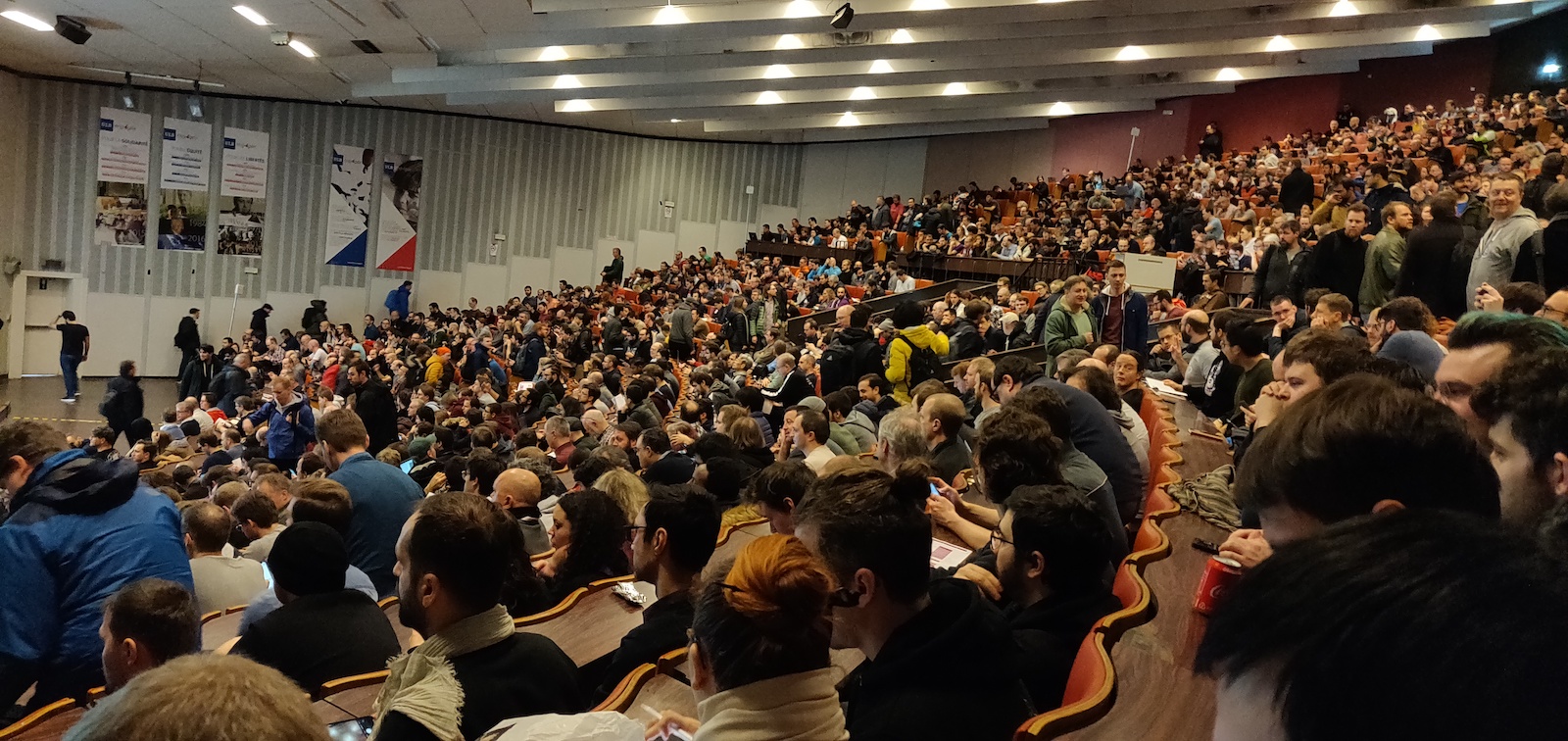 FOSDEM 2020 last weekend brought together 8,000+ developers in Brussels united by the idea of open source software. 2 days, 800 speakers and reports, unlimited communication and the opportunity to meet legends from the world of OpenSource. I share my impressions and notes from the speeches. Video reports were posted here (and this, no less, 420 hours of content).
FOSDEM 2020 last weekend brought together 8,000+ developers in Brussels united by the idea of open source software. 2 days, 800 speakers and reports, unlimited communication and the opportunity to meet legends from the world of OpenSource. I share my impressions and notes from the speeches. Video reports were posted here (and this, no less, 420 hours of content).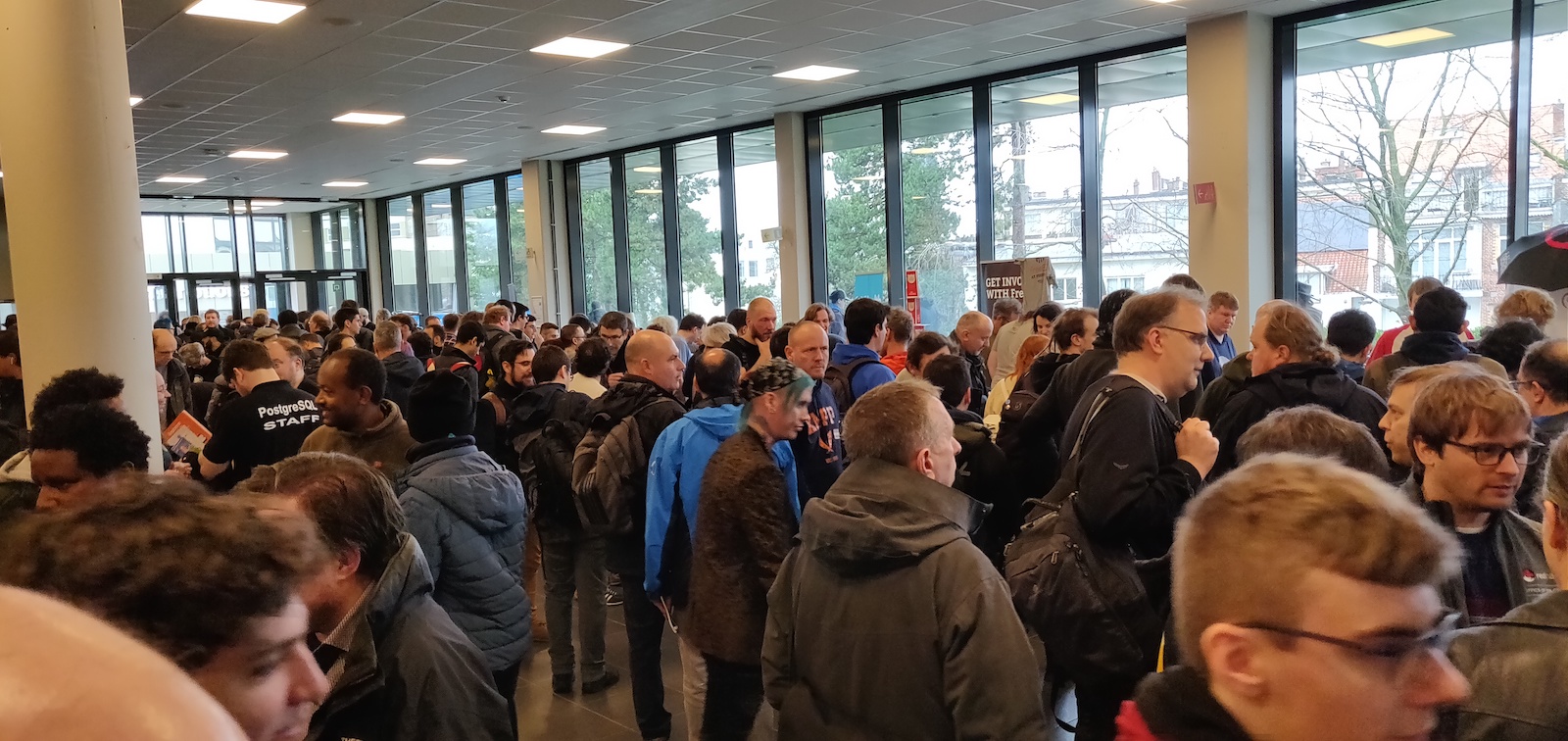 Full house near the stands of Linux distributions.
Full house near the stands of Linux distributions.General impressions
At the very beginning, the scale of the conference is striking - a huge number of geeks scurrying around the Free University of Brussels . Admission to the conference is free, streams are distributed between 30+ parallel tracks. There were a lot of visitors, sometimes, to get to the popular report, people came in half an hour and took the queue. In addition to content, it was useful to communicate with developers from OpenSource products. Unlike ordinary conferences, where company representatives compete at the stands who best give visitors, the opposite is true: the stands give visitors the opportunity to support their favorite product by buying a branded souvenir. I heard that many perceive FOSDEM as an excellent annual occasion to meet with colleagues and friends in real life.Next will go the notes that I made on the reports.
How foss could revolutionize municipal government
fosdem.org/2020/schedule/event/municipal_government (description)Danese Cooper threw examples when in small cities where there is no staff of developers, OpenSource solved the problems. In large cities, there is the possibility of their own development, such as Code for America , or Paris Lutece , but they have their own problem: the state as a whole does not care how the software is developed. For proprietary solutions, compared with FOSS (Free and Open Source Software), the advantage is the ability to call where you need it when something does not work. At the end, a call to unite and organize movements such as OSPO for Cities .
The Selfish Contributor Explained
fosdem.org/2020/schedule/event/selfish_contributor (description, presentation, video)Many people at OpenSource are wondering how to bring other contributors to the project. Participation in development is a pragmatic exercise, understanding why people are contributing will help focus the product in the right direction. A simple request to make a contribution does not work. As an option - to collect from people suggestions and advice on improvements, but not promise to implement. It is important to mention publicly the contributions of contributors.
How can we give users standing in free / open software / hardware?
fosdem.org/2020/schedule/event/user_standing (description) The difference between users and developers according to Italo Vignoli .Users are not idiots, but professionals. But only in his non-IT environment. They have no desire to invest time in litigation with OpenSource programs, which are usually not so user-friendly. Users are happy with proprietary software because this is the only thing they know. If you make FOSS clear and simple, they will use free software. Plus, the speaker advises marketing his developments.
The difference between users and developers according to Italo Vignoli .Users are not idiots, but professionals. But only in his non-IT environment. They have no desire to invest time in litigation with OpenSource programs, which are usually not so user-friendly. Users are happy with proprietary software because this is the only thing they know. If you make FOSS clear and simple, they will use free software. Plus, the speaker advises marketing his developments.
Double your contributors using these 3 simple tricks!
fosdem.org/2020/schedule/event/gamedev_double_contributors_tricks (description, slides, video)The clickbait name hides the idea that the secret of the OpenSource product’s success is “scratching where it itches”. Firstly, you can take a niche where there are no free alternatives to paid software and file an analogue. The second, as an option, is to create an MVP and hook people on it. They will want to change something, and you will provide such an opportunity. The third life hack is “be nice” and people will stretch. Work on the TOFFEE (Time of Onboarding, Finding & Fixing an issue End to End) metric.Bonus trick how to double the number of contributors - join an existing project with 1 contributor.
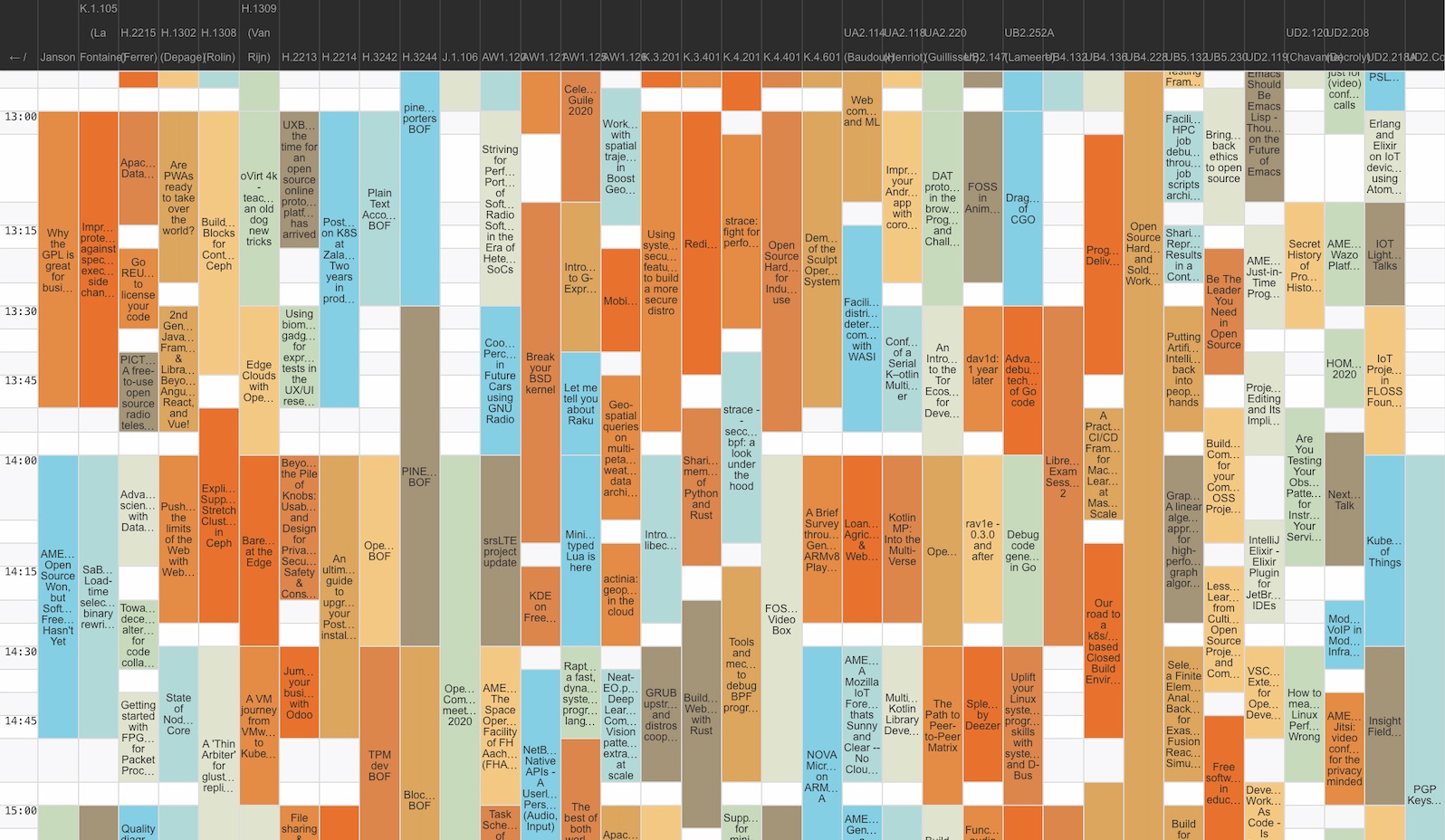 Schedule reports. Where is lunch here?
Schedule reports. Where is lunch here?
Lessons Learned from Cultivating Open Source Projects and Communities
fosdem.org/2020/schedule/event/osslessons (description, video)Another report that advises against spraying and “scratch your own itch” is to solve a problem that you yourself suffer from. In the case when you support the company's OpenSource product, think about the great goal that you bring to the world. Secrets of success: the presence of a global vision with a roadmap, empathy for the audience and do not forget to arrange holidays on pleasant occasions, for example, the release of a major release.
How Containers and Kubernetes re-defined the GNU / Linux Operating System
fosdem.org/2020/schedule/event/riek_kubernetes (description, video) Astory about the evolution of software delivery methods. Package managers, then configuration management systems, then the era of virtualization and the emergence of corporate and public clouds. The final iteration is evolution with containers and container orchestrators. It’s cool that the containers themselves are independent of the vendor, but at the same time, the infrastructure can be consumed as a service.
 FULL signs hung in front of crowded audiences. Latecomers had the opportunity to watch the broadcast online through the local Wi-Fi.
FULL signs hung in front of crowded audiences. Latecomers had the opportunity to watch the broadcast online through the local Wi-Fi.
Precise, cross-project code navigation at GitHub scale
fosdem.org/2020/schedule/event/github_cross_project_code_navigation (description, slides, video)You can’t just grab and code navigation in the github. It is necessary to shovel and parse a ton of code, somewhere to store and incrementally update the dependency tree of the entire code from all branches of repositories. I have not thought about the complexity of such tasks before.
Advancing the Future of CI / CD Together
fosdem.org/2020/schedule/event/continuous_delivery_foundry (description, video, slides)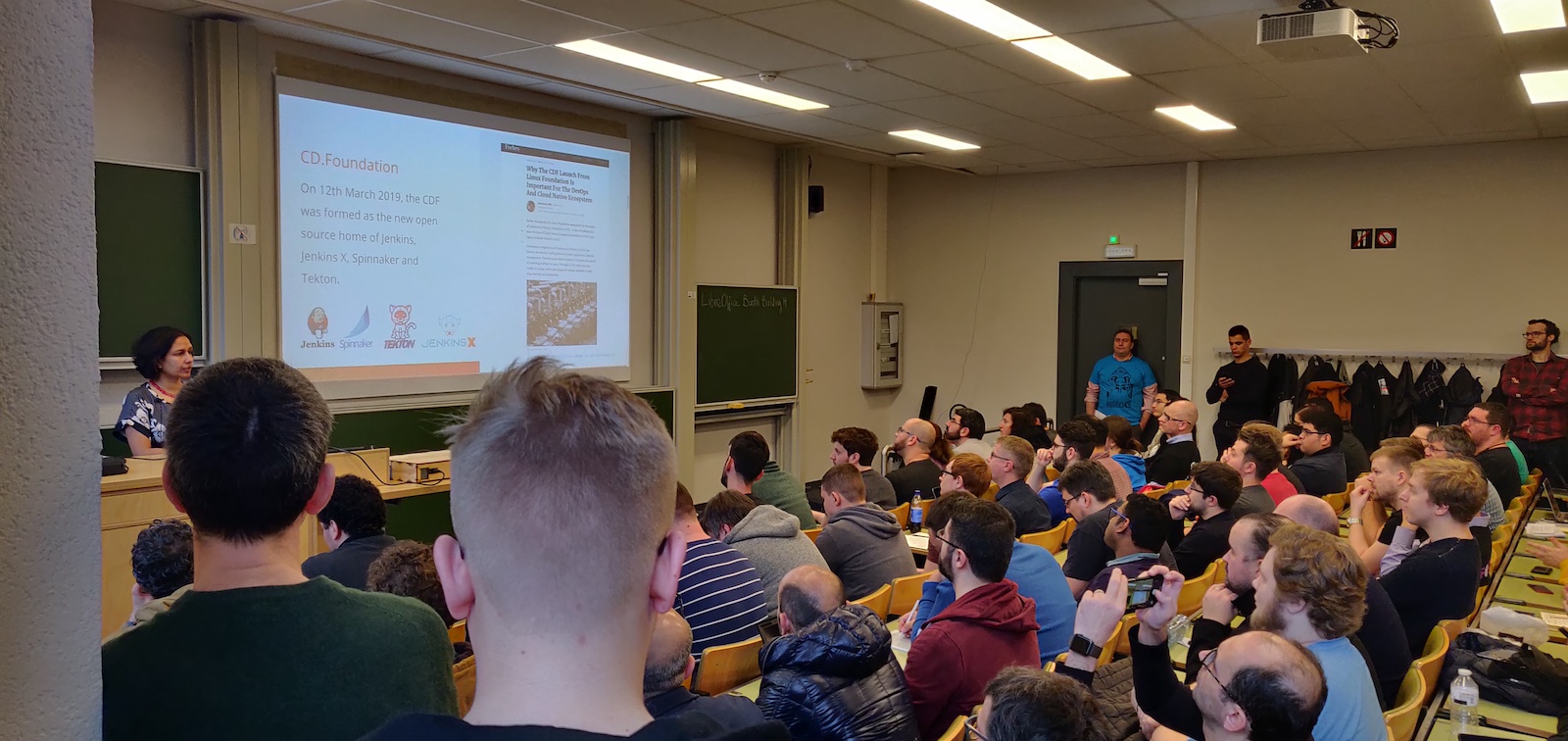 I managed to take a place on the windowsill since the last report, most of those who wanted simply did not fit into the audience.Story about the Continuous Delivery Foundation created last year. The three main problems of CI / CD are the emergence of microservices with their needs, the variety of CI / CD tools and the complexity of the changes. The purpose of the creation is to restore order in this area. They make a CI / CD landscape (just like in CNCF ), carry out Continuous Delivery mitaps (mainly according to Jenkins), standardize tools (for example, collect terminology in different programs), create different parties - for example sig-mlops- where they want to clean up CI / CD Machine Learning.Possible for them to join .
I managed to take a place on the windowsill since the last report, most of those who wanted simply did not fit into the audience.Story about the Continuous Delivery Foundation created last year. The three main problems of CI / CD are the emergence of microservices with their needs, the variety of CI / CD tools and the complexity of the changes. The purpose of the creation is to restore order in this area. They make a CI / CD landscape (just like in CNCF ), carry out Continuous Delivery mitaps (mainly according to Jenkins), standardize tools (for example, collect terminology in different programs), create different parties - for example sig-mlops- where they want to clean up CI / CD Machine Learning.Possible for them to join .
Automate your workflows with Kotlin
fosdem.org/2020/schedule/event/kotlin_automate_your_workflows (description, slides)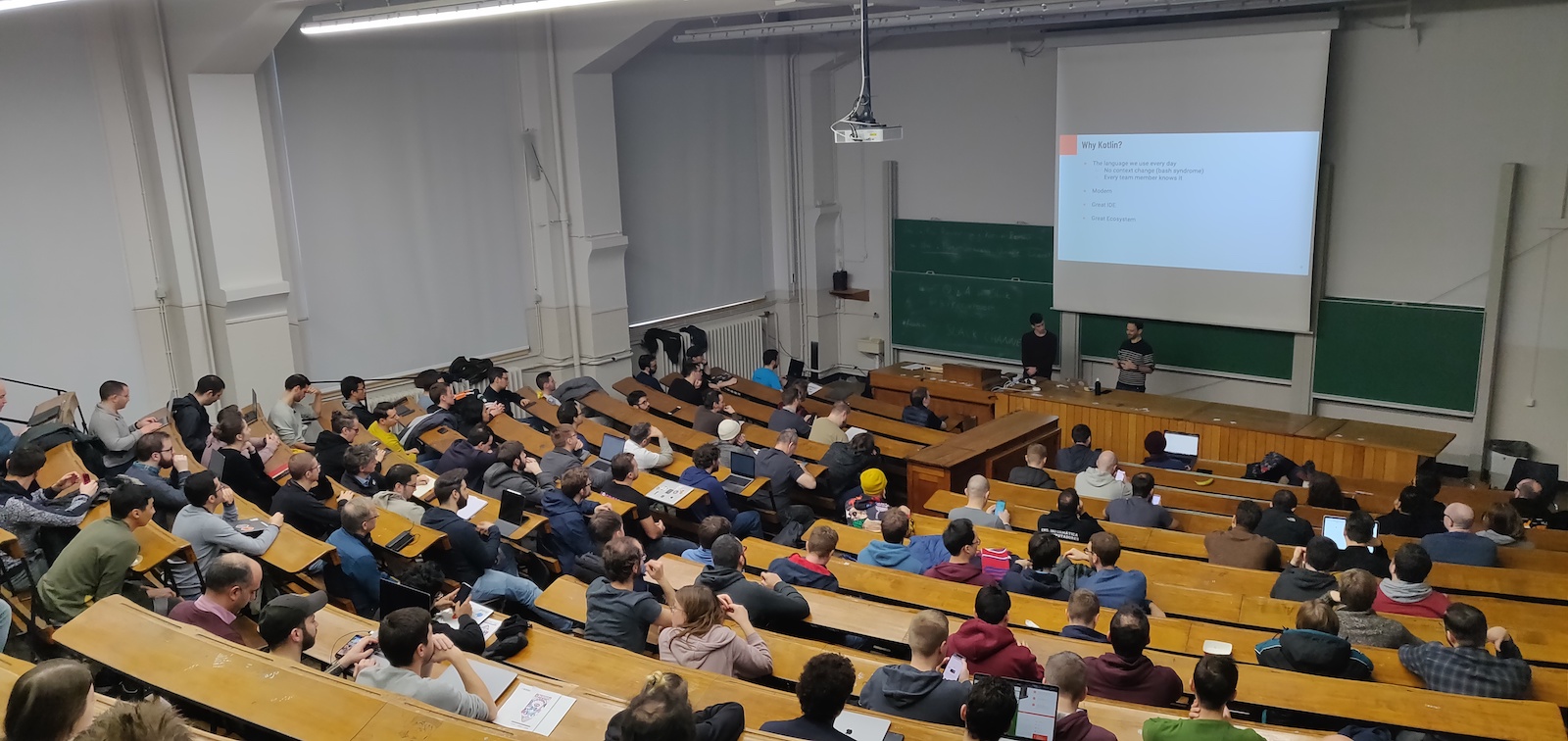 Audiences gave charm to what is happening.The story of the guys developing applications for android, how they rewrote ruby, bash and groovy scripts on Kotlin. Now they have a language that is understandable to developers everywhere. We installed Kscript , connected plugins, installed clikt , wrote the internal tool kinta, which makes automation out of the box. They say they don’t know troubles, but I didn’t believe it.
Audiences gave charm to what is happening.The story of the guys developing applications for android, how they rewrote ruby, bash and groovy scripts on Kotlin. Now they have a language that is understandable to developers everywhere. We installed Kscript , connected plugins, installed clikt , wrote the internal tool kinta, which makes automation out of the box. They say they don’t know troubles, but I didn’t believe it.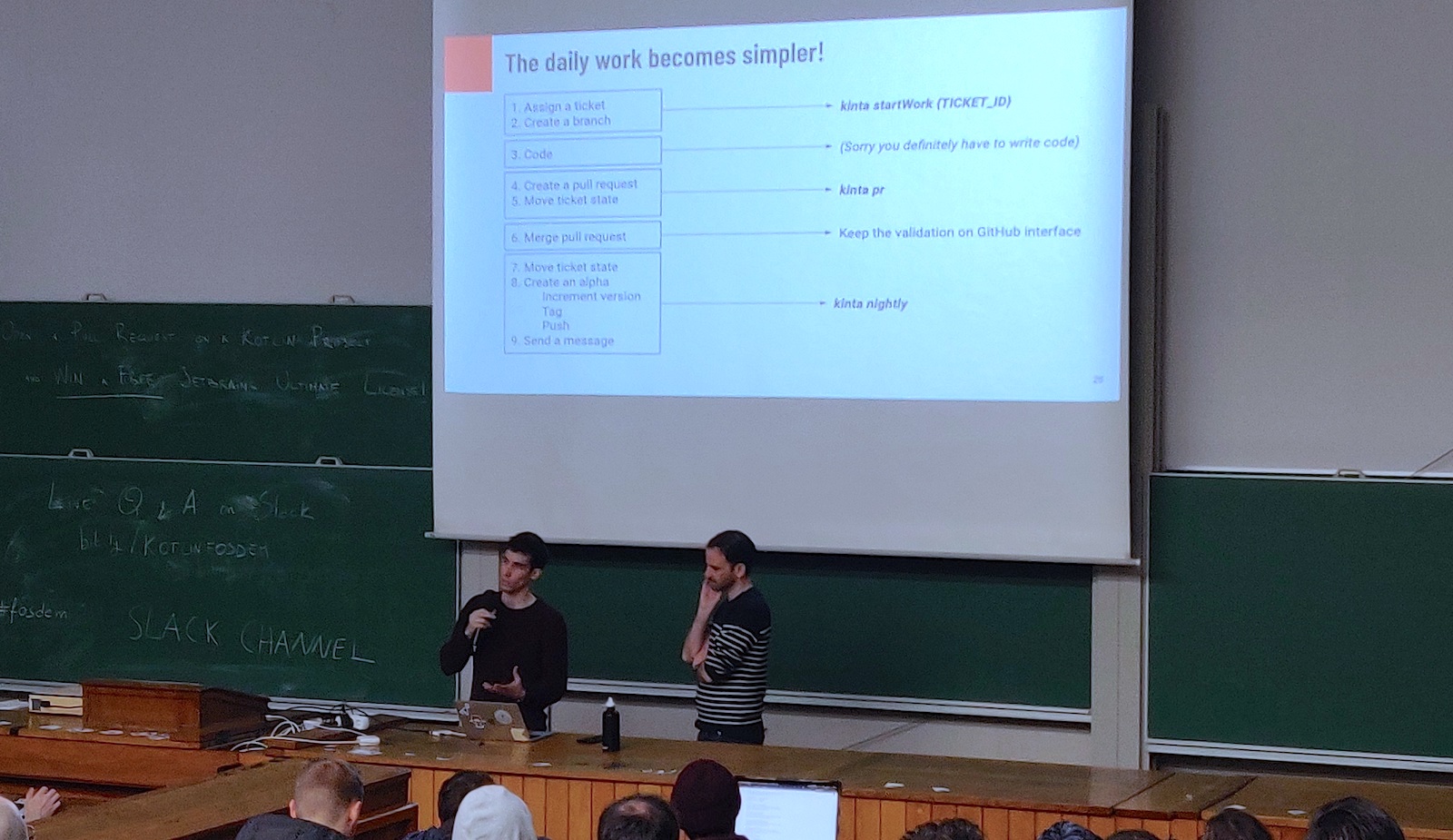 Kinta features. They say they will open up when they comb.
Kinta features. They say they will open up when they comb.
Why the GPL is great for business
fosdem.org/2020/schedule/event/gpl_and_business (description)First, an overview of license models from the most closed to the liberal. Then, about the ways to earn an OpenSource product: trade with merchandise, provide a product like SaaS , partnership with funds (for example, CNCF ), certification and brand license, donations, Bounty Driven Development (when they pay for completed features), selling ads, Delayed Open Source (you give away the latest version only to those who paid), the release of a paid pro version (though this is negative, is this an open source), the provision of paid support and different models of double licenses (when you can pay and ignore copyleft restrictions). Found on Wikipediafull list of ways . It’s difficult to make money on your own SAAS in the cloud era, so sometimes it’s forbidden for public cloud providers to provide software as a service without the permission of the creator. (Redis, MongoDB, CockroachDB). The main conclusion of the report: copyleft licenses (for example, GPL ) will help OpenSource programs to earn a living and will develop the ecosystem and community around the product.
Free software in education
fosdem.org/2020/schedule/event/edufoss (description, videos, slides and links)How children can use FOSS: search for information, communicate, consume entertaining content, use special educational applications at home and in computer classes. FOSS itself is poorly used in schools, so the guys founded the schul-frei movement. They collect the OpenSource collection, which is useful in school (did not find it on the Internet) and attract local IT companies to support this software.
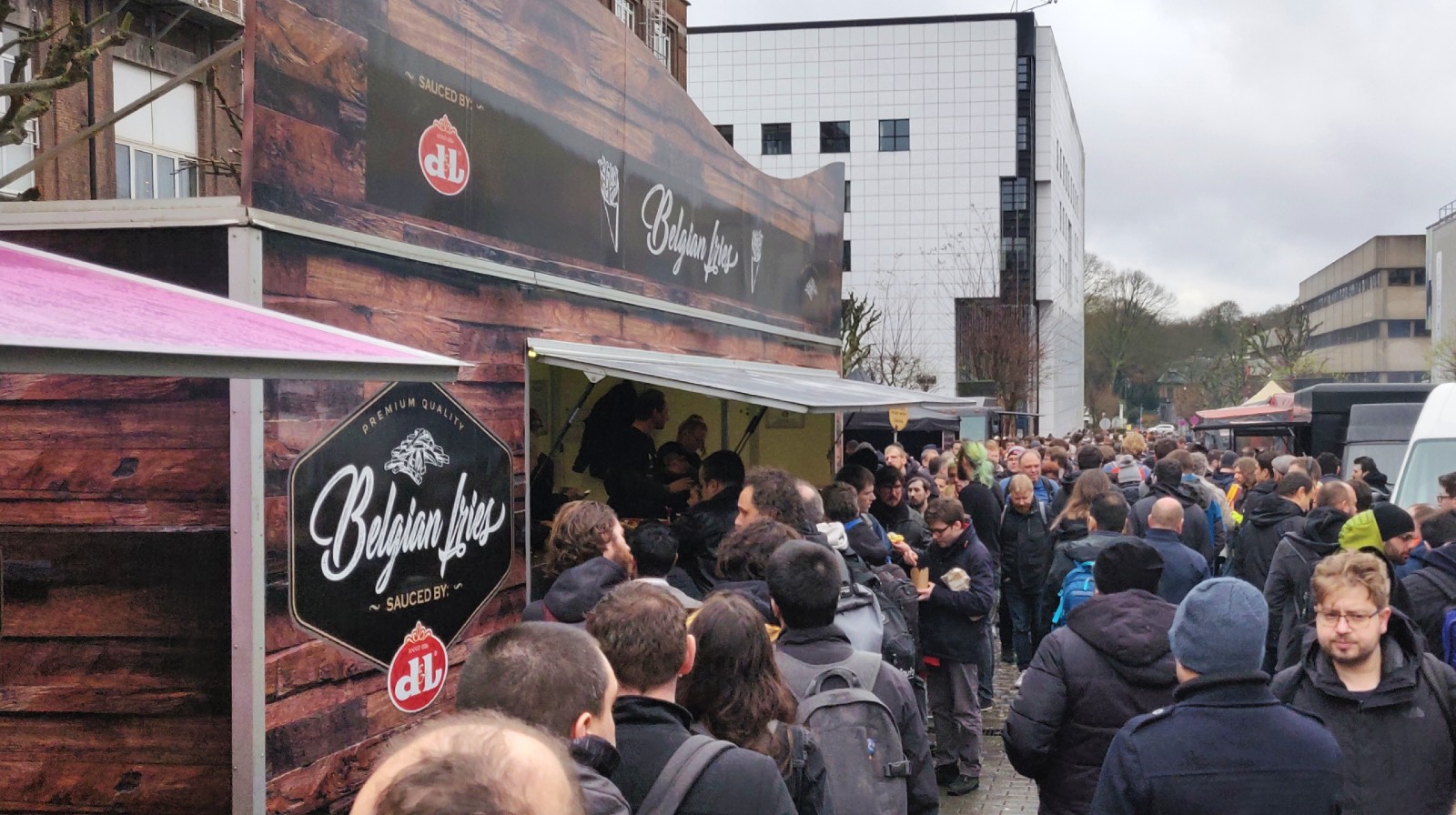 French fries are called "French fries" all over the world, and they came up with it in Belgium. Like this.
French fries are called "French fries" all over the world, and they came up with it in Belgium. Like this.
Engaging Enterprise consumers of OSS
fosdem.org/2020/schedule/event/enterpriseoss (description, video, links) Itbecame fashionable to participate in large companies in OpenSource, so new nuances surfaced. When a person contributes voluntarily, he is often interested in completing the pull request. When he works on a contract, he can quit. How to live with it: speed up the onboard, split pull requests, measure everything, use “on behalf” and determine intentions by the person’s profile. OSPO is in all large corporations, there, as a rule, there is an examination of the correct organization of OpenSource. Books to read: Accelerate , Community Development as a Process andThe Comingled Code: Open Source and Economic Development
Building a thriving community in company-led open source projects
fosdem.org/2020/schedule/event/corpcommunitythrive (description, slides, videos)Why do people participate in other companies' OpenSource products: a love of technology, an opportunity for professional growth, a sense of belonging.Accordingly, how to help:- Facilitate the threshold of entry: increase the availability of information, invite to participate in discussions, make decisions transparently
- Declare affiliation: do events, give leadership to directions, invite to the office
- Advertise contributors: write blogs, invite to panel discussions, send written acknowledgment.
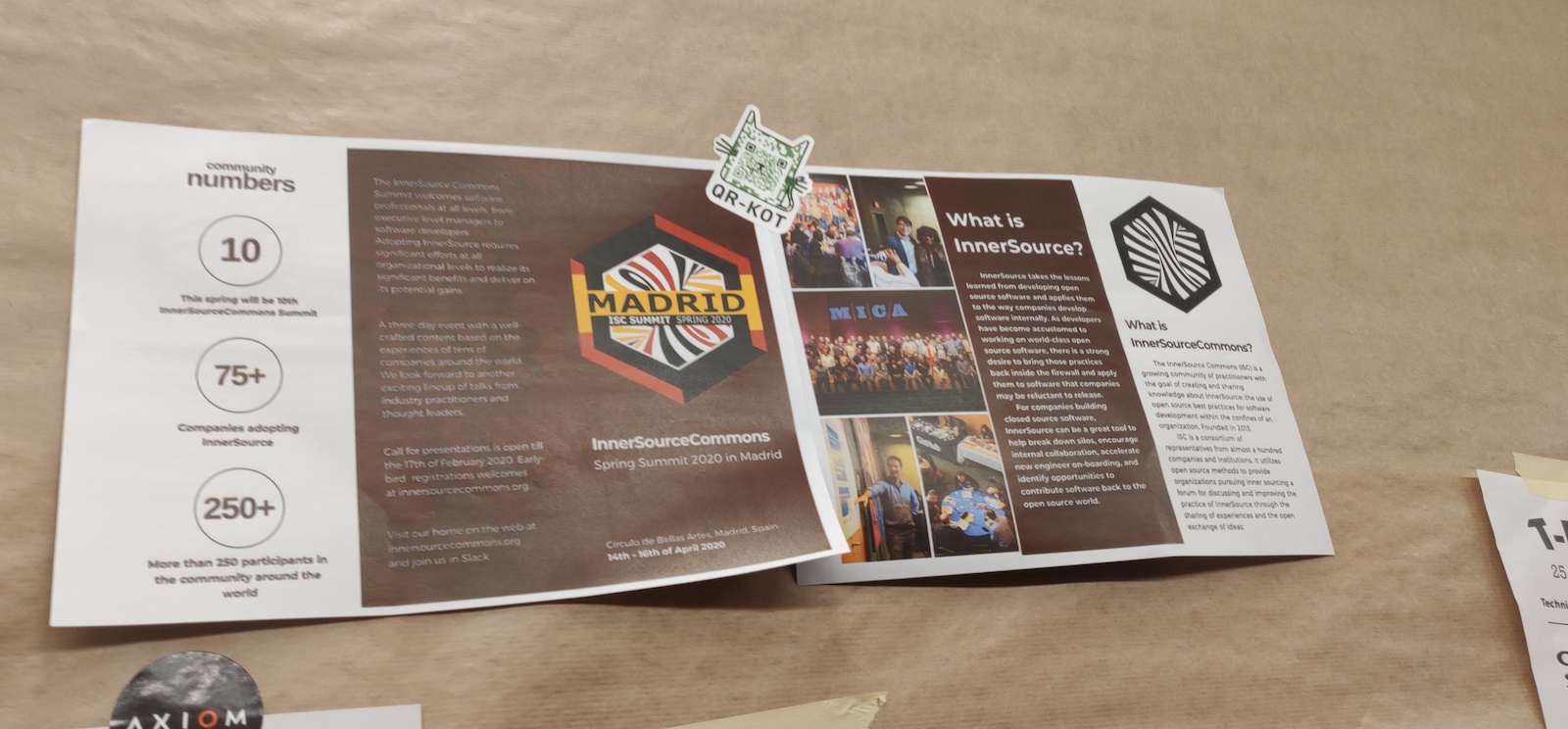 Leroy stickers with a QR cat leading to a secret video came in handy .
Leroy stickers with a QR cat leading to a secret video came in handy .
How I got to FOSDEM
The conference is a great way to join the OpenSource culture, not to stare and meet with cool IT specialists. For example, with the guys from InnerSourceCommons , the global InnerSource community. I am promoting this approach: as in OpenSource, only within the boundaries of the company. In open source people have learned to develop complex programs, being on several continents and speaking different languages, and they are doing this very successfully. A logical step is to reuse the best practices in internal development. I’ll talk about this later. And now I will be happy to discuss the theses in the comments.Source: https://habr.com/ru/post/undefined/
All Articles